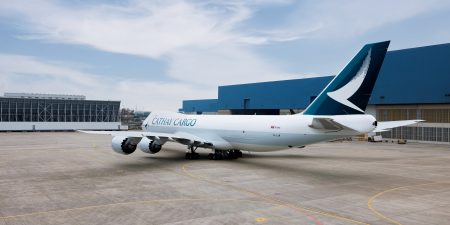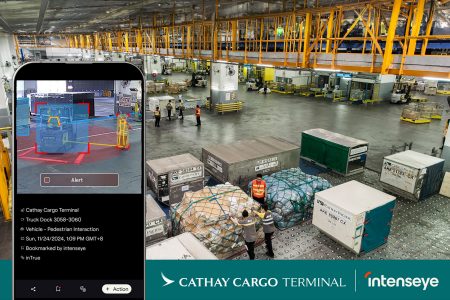While there is little doubt that AI is the talk of air cargo’s digitalised future, there are many hoops to go through first. There are some real-world examples from the Cathay Cargo Terminal and Cathay’s ground handling agent subsidiary HAS (Hong Kong Airport Services) below where AI is already proving its value. But that’s the point. It’s not necessarily the solution to every problem – it must first prove itself.
Perhaps you got to this story from the search function on the Cathay Cargo website. If so, you will have used an “AI semantic search” algorithm to get here, rather than a standard keyword search. “It’s a smarter search tool, and because it’s small it could be launched quickly,” says Head of Cargo Digital Andress Lam.
This search project also shares some of the characteristics with a lot of Cathay Cargo’s work with AI so far. “We have been looking at AI in the back end for data analysis, for things like optimising pricing, or optimising the operational checks that we do,” Lam says. “So the impact of AI is less immediately visible than some of the functionality you see on the operations side with screening and so on.”
Cathay Cargo has run multiple proof of concept (POCs) projects using AI – some have been successful, others not. A lot of AI projects adopt “machine learning”, which is able to scan structured data to learn and recognise patterns. This is very much behind many potential air-cargo AI solutions, as they are much quicker at disseminating and categorising data than we are.
While the industry is becoming progressively paper-free, air cargo still generates a lot of data with every shipment. Every shipment also has to cross-reference various regulations, customs requirements and so on, as GM Cargo Service Delivery Tim Wong explains. “Our services team all have thick books on their desks covering DG, live animal, perishable regulations – around 3,000 pages,” he says. “We are exploring how to use AI, and the large language model of AI, to help us to digest this information and make it more consumable.”
The Cargo Digital team is currently working on a POC using the large language model to handle import and export controls using smart checking to ensure that licences are provided for certain types of commodities. “We're creating a business case for this by the end of the year,” says Lam.
As to the future, the focus will be on further developing data analytics to enable more accurate forecasting. “Data is our asset in many ways, so we are looking to use machine learning to improve how we use it to manage our capacity, pricing and also to learn more about market and booking behaviours,” says Lam.
Real world AI use cases
AI-powered safety analytics
Following a successful proof of concept, Cathay Cargo Terminal has become the first air cargo terminal in Hong Kong to introduce a state-of-the-art safety monitoring system powered by AI and integrated with its existing CCTV surveillance infrastructure to provide real-time monitoring and reporting focusing on potential safety and security risks. These include situations like people not wearing the right protective equipment, straying from pedestrian walkways, or vehicles or equipment moving too close to each other or to workers. Working with Intenseye, a leader in AI powered workplace safety solutions, the system is designed with a strong emphasis on privacy and concentrates on identifying hazardous situations rather than individuals, which fits what the cargo terminal’s “Just Culure”.
“Safety is the cornerstone of our success and always a top priority for us,” says Chief Operating Officer Mark Watts. “AI will not replace our existing safety management systems or protocols, but can augment and improve them. The beauty of this system is it works with our existing cameras. We have already implemented the system on cameras covering high-risk areas and we will gradually roll out into more areas next year as the machine learning takes effect.”
The initial success was so encouraging, the project has been extended to security too, such as flagging when the wrong people are in the wrong place or if cargo seems to be unattended by agents at the truck docks, a feature specially developed for Cathay Cargo Terminal.
AI for lithium screening
In addition to AI-powered video analytics, CCT is also embracing AI technology for its enhanced lithium screening, which is another critical aspect of safety. The work dates back to last summer when the terminal pioneered a enhanced programme for screening for mis-declared lithium batteries using a proprietary image library..
“The industry has come a long way in identifying undeclared lithium, but we saw a potential risk in mis-declared lithium,” says Watts. “For example, batteries declared to be lower power for smaller devices, but that turned out to be the bigger batteries that might go into e-bikes.”
AI lithium screening involves using advanced algorithms to accurately detect and identify lithium batteries in shipments, reducing the risk of fire hazards associated with these potentially volatile items.
“We introduced enhanced screening at the Cathay Cargo Terminal well over a year ago,” says Watts and it has since become an industry standard in Hong Kong thanks to the support of Cathay Cargo. “We're now installing AI onto all of our x-ray machines, so whenever there’s any loose cargo or prepacked cargo that hasn't been pre-screened upstream, the AI can augment the process and make it even less likely that mis- or undeclared lithium can get into our terminal.”
The next stage, already underway, is to strengthen the safety armoury by introducing thermal imaging technology, where potential temperature anomalies can be identified and addressed promptly.
HAS safer driving initiative
The Cathay Group’s wholly owned ground handling agent HAS (Hong Kong Airport Services) has introduced a pioneering AI surveillance system proof of concept to monitor driver behaviour on its vehicles operating in and around the airport. The initial trial used buses that ply Cathay people between various sites around the airport. Using on-board cameras to monitor drivers and another to monitor the road, it uses real-time telemetry broadcast over 4G and then machine learning to identify and log undesirable driving behaviours, from visible tiredness and inattention, to speeding in restricted areas and sudden braking or acceleration.
The data creates heatmaps to identify specific locations for behavioural improvement or for greater care to be taken, while also monitoring driver alertness. Having identified potential problem areas, managers were able to raise awareness and reinforce training, which has led to marked decrease in the incidence of less than ideal driving behaviours. Since its introduction and while the logged miles per month increased as the trial progressed, concerning driver behaviour has halved, showing the scheme’s effectiveness in tandem with a safe driving training programme.

